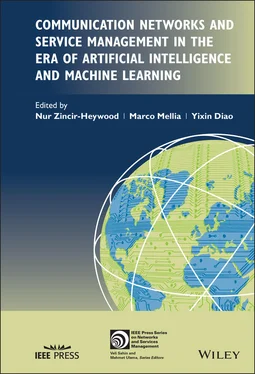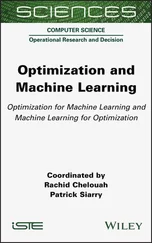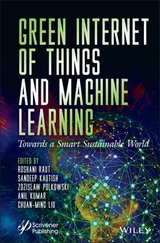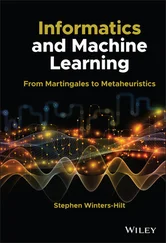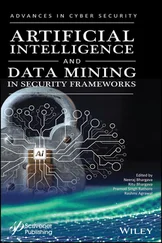Security management is another network/service management field that includes extensive and early endorsement of AI/ML techniques. Network anomaly detection is a prime example, in which ML techniques are applied for their ability to automatically learn from the data and extract patterns that can be used for identifying network anomalies in a timely manner [31]. To this end, temporal correlation [32], wavelet analysis [33], and traditional change point detection [34] approaches are applied to produce normal/malicious traffic models, where the sequence of actions in a time window are used to create profiles using clustering techniques such as Self Organizing Maps [35], K‐means [36], and Gaussian Mixture Models [37]. Moreover, AI/ML techniques have been applied to network intrusion detection including, but not limited to, Decision Trees, Evolutionary Computing, Bayesian Networks, Support Vector Machines, and recently Deep and Reinforcement Learning [38–43]. Unsupervised learning and Stream online learning have been employed for security tasks as well [44, 45]. Other examples of AI/ML applications in security are moving target defence, insider threat detection, and network content filtering [46–48].
In fault management, prediction and diagnosis of faults attracted widespread use of AI/ML techniques from online learning for change point detection to Neural Networks to Hidden Markov Models to Decision Trees, and several unsupervised learning algorithms [49–53]. Additionally, other AI/ML have been introduced specifically for fault prediction, automated fault mitigation, and root cause analysis [54–57].
The application of AI/ML techniques have been slower in configuration management tasks. However, as discussed earlier, with the introduction of NFV and SDN technologies, this is changing [58–60]. Initiatives such as Intent Based Networking [61] and Zero Touch Networking [62] widespread usage of AI/ML has been seen in wireless networks. Other example tasks in configuration management employing ML are service configuration management network load balancing and routing [63–68].
In summary, AI/ML techniques have been applied to several tasks of network and service management in greater numbers over the last decade [69]. However, there are still challenges that need to be resolved for the successful usage of such techniques in production environments. One of the challenges is obtaining high quality data for training and evaluating ML techniques for network and service management functions. Even though network/service data is plenty and diverse in real world, most of the time it is difficult to obtain such data with ground truth. In return, this not only poses challenges for evaluating AI/ML techniques but also faces privacy and trust issues. Another challenge is that in today's networks/services data are generated nonstop in high volume and velocity. They include stationary as well as non‐stationary behaviors superimposed. They evolve continuously as new protocols and technologies are introduced over time. All of these reflect in the data in one shape or form, as gradual drifts in user/system behaviors, or as sudden shifts maybe because of a malfunctioning device or a denial of service attack on a particular network or service. This means that AI/ML techniques require to take these dynamics and changes into account, learn under the aforementioned conditions in order to ensure successful deployment. Yet, another challenge is the need of human experts (from network engineers to security analysts to network/service managers) to understand and trust to AI/ML based system and tools. This requires transparent AI/ML techniques for expert involvement and trust. This is of utmost importance for the widespread and successful deployment of AI/ML techniques in network and service management.
Finally, these challenges also create opportunities in the form of a need for transparent, robust, and dependable AI/ML based techniques for network and service management. To this end, we have already started to see the applications of stream learning, adversarial learning, and transfer learning to the network and service management solutions. Furthermore, research in transparent, secure, and robust AI/ML techniques have gained a big momentum in the ML community. Given the scale and dynamics of today's networks/services, we envision that the application of AI/ML techniques will become more and more ubiquitous and central for operations and management of the future services and networks. In the following
Chapters – , we will introduce the current state and the new trends of the AI/ML applications in network and service management.
1 1 D'Alconzo, A., Drago, I., Morichetta, A. et al. (2019). A survey on big data for network traffic monitoring and analysis. IEEE Transactions on Network and Service Management 16 (3): 800–813.
2 2 Diao, Y. and Shwartz, L. (2017). Building automated data driven systems for it service management. Journal of Network and Systems Management 25 (4): 848–883.
3 3 Alshammari, R. and Zincir‐Heywood, N. (2015). How robust can a machine learning approach be for classifying encrypted VoIP? Journal of Network and Systems Management 23 (4): 830–869.
4 4 Boden, M.A. (2016). AI Its Nature and Future. Oxford University Press. ISBN 9780198777984.
5 5 Bernstein, L. and Yuhas, C.M. (1988). Expert systems in network management‐the second revolution. IEEE Journal on Selected Areas in Communications 6 (5): 784–787.
6 6 Tran, H.M. and Schönwälder, J. (2015). Discaria: distributed case‐based reasoning system for fault management. IEEE Transactions on Network and Service Management 12 (4): 540–553.
7 7 Fallon, L. and OSullivan, D. (2014). The Aesop approach for semantic‐based end‐user service optimization. IEEE Transactions on Network and Service Management 11 (2): 220–234.
8 8 Alpaydin, E. (2020). Introduction to Machine Learning, vol. 4. MIT Press. ISBN 9780262043793.
9 9 Buczak, A.L. and Guven, E. (2016). A survey of data mining and machine learning methods for cyber security intrusion detection. IEEE Communication Surveys and Tutorials 18 (2): 1153–1176. https://doi.org/10.1109/COMST.2015.2494502.
10 10 Wang, M., Cui, Y., Wang, X. et al. (2017). Machine learning for networking: workflow, advances and opportunities. IEEE Network 32 (2): 92–99.
11 11 Calyam, P., Dhanapalan, M., Sridharan, M. et al. (2014). Topology‐aware correlated network anomaly event detection and diagnosis. Journal of Network and Systems Management 22 (2): 208–234.
12 12 Bhuyan, M.H., Bhattacharyya, D.K., and Kalita, J.K. (2014). Network anomaly detection: methods, systems and tools. IEEE Communications Surveys and Tutorials 16 (1): 303–336. https://doi.org/10.1109/SURV.2013.052213.00046. URL
13 13 Le, D.C. and Zincir‐Heywood, N. (2018). Big data in network anomaly detection. In: Encyclopedia of Big Data Technologies (ed. S. Sakr and A. Zomaya), 1–9. Cham: Springer International Publishing. ISBN 978‐3‐319‐63962‐8. https://doi.org/10.1007/978‐3‐319‐63962‐8_161‐1.
14 14 Nawrocki, P. and Sniezynski, B. (2018). Adaptive service management in mobile cloud computing by means of supervised and reinforcement learning. Journal of Network and Systems Management 26 (1): 1–22.
15 15 Bachl, M., Zseby, T., and Fabini, J. (2019). Rax: deep reinforcement learning for congestion control. ICC 2019‐2019 IEEE International Conference on Communications (ICC), IEEE, pp. 1–6.
16 16 Amiri, R., Almasi, M.A., Andrews, J.G., and Mehrpouyan, H. (2019). Reinforcement learning for self organization and power control of two‐tier heterogeneous networks. IEEE Transactions on Wireless Communications 18 (8): 3933–3947.
17 17 Boutaba, R., Salahuddin, M.A., Limam, N. et al. (2018). A comprehensive survey on machine learning for networking: evolution, applications and research opportunities. Journal of Internet Services and Applications 9 (1): https://doi.org/10.1186/s13174‐018‐0087‐2.
Читать дальше
